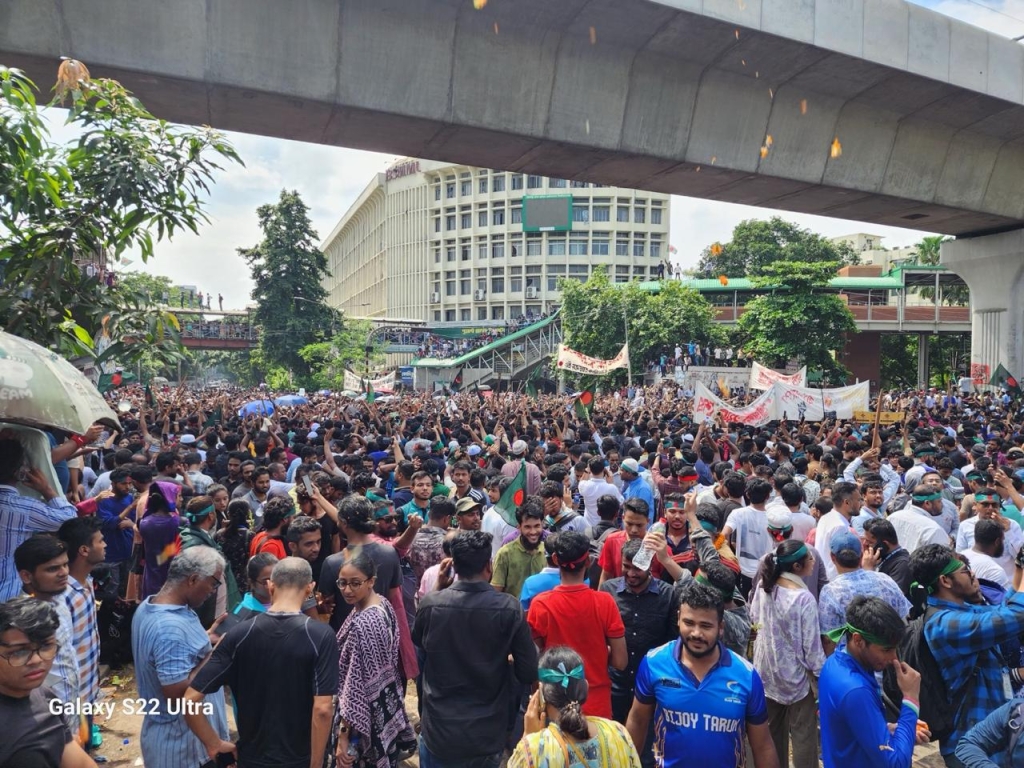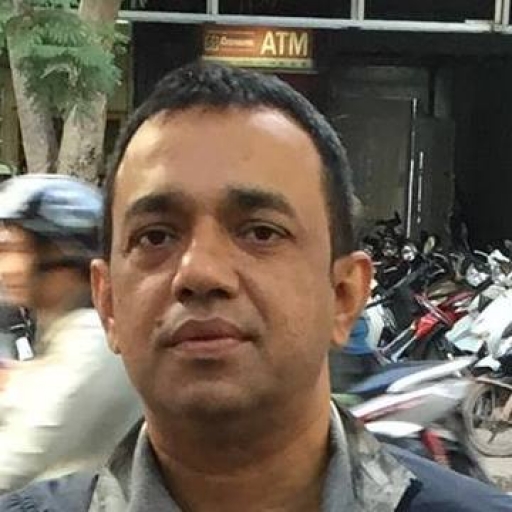কালরাত থেকে মনে হচ্ছিল আজ ৫ আগস্ট দিনটা একটা বিশেষ দিন হবে। মার্চ টু ঢাকা প্রোগ্রামটা শাহবাগকে কেন্দ্র করে হবে তাই ঠিক করেছিলাম আমি নিজে শাহবাগ থাকবো।

আমার একটা সাদা রঙের ভেসপা আছে। ওটা নিলাম।
সকাল সাড়ে এগারোটায় বেরুলাম, বনানী হয়ে এয়ারপোর্ট রোড হয়ে শাহবাগ যাবো। কিন্তু বনানী পর্যন্ত এসে বৃষ্টির জন্য আর যেতে পারলাম না। বাসায় ফিরে টিভি খুলে দেখি ঢাকায় চরম কার্ফু। সব দিক দিয়ে ঢাকা যেন বন্ধ করে রেখেছে।
আমার মাথায় কাজ করছে আমি নিজ চোখে এই কার্ফু দেখবো শাহবাগে দাঁড়িয়েই।
সাড়ে বারোটায় আবার বেরুলাম, এবার হাতিরঝিল হয়ে এফডিসি বাংলামোটর ধরে যাবো। বেড়িয়ে দেখি রাস্তা একেবারেই শুন্য। দিনের বেলা কিন্তু গা ছমছম করার মতন নির্জন, কোথাও কোন শব্দ নাই। হাতিরঝিল বেঞ্চে যারা সারাক্ষণ শুয়ে বসে থাকে তারাও নেই। পুলিশ, ট্রাফিক বা ভিক্ষুক কেউ নেই, একমাত্র আমি চলছি। সোনারগাঁও হোটেলের মোড়ে এসে এদিক সেদিক দু একজনকে চলাচল করতে দেখেছি। বাংলামোটর পার হয়ে দেখলাম দুরে সাকুরার সামনে মিলিটারি হেলমেট। শাহবাগের দিকের রাস্তা বন্ধ করে দাঁড়িয়ে আছে। একটু পিছনে অনেক পুলিশ। তার কাছাকাছি পরিবাগের গলির মাথায় দেখলাম বেশ কিছু লোক। বেশিভাগই ছাত্র ছাত্রী। সংখ্যায় খুব বেশী না, ফুটপাথে বসে আছে, দাঁড়িয়ে কথা বলছে। কোন উত্তেজনা নেই কোন কিছুর প্রস্তুতি নেই। আমি আমার বাইক একটু দূরে রেখে দিলাম। কিছু ছবি তুললাম। দুয়েকটা রিকশা এসে থামছিল। একটা থেকে তিনটা মেয়ে নামলো। একজন মাথায় হিজাব বাকি দুজন টিশার্ট। সবাই জিনস পড়েছে ও পায়ে কেডস। গতরাতে সমন্বয়কদের নির্দেশনার কথা মনে পড়লো, ওরা সবাইক কেডস পরে আসতে বলেছে আর সবার মোবাইল স্ক্রিণে নিজের নাম, ঠিকানা, ব্লাড গ্রুপ আর ইমারজেন্সি ফোন নাম্বার পিন করে রাখতে বলেছিল। এটাতো ভীষণ ভয় পাইয়ে দেবার কথা, প্রোগ্রামে নামার আগে কেও কখনো নিজ মৃত্যুঝুঁকির কথা মনে করিয়ে দেয় নাকি? আমার কাছে এটাকে বেশ অভিনব মনে হয়েছিল। পরে শুনেছি অনেকেই মোবাইল স্ক্রিনে এগুলো লিখেই বেড়িয়েছিল।

সময় যত যাচ্ছিল সংখ্যাটা বাড়ছিল। এদিকে ইন্টারনেট অনেক আগ থেকেই নেই। একসময় একজন আমার পাশে এসে দাঁড়িয়ে ফিস ফিস করে বলল পিছনের দিকে একটা গেইট আছে, খুব ইজি। দেখলাম ত্রিশের কাছাকাছি এক লোক। আমি অবাক যে হয়েছি এটা না বুঝিয়ে খুব স্বাভাবিক ভাবেই জিজ্ঞেস করলাম কোন দিকের পিছনটা? উনি বললেন লাকের পাশ ঘিড়ে, সব রেকি করে আসছি। মাত্র দুইটা আর্মি গার্ড দিতেছে। আমি বুঝলাম উনি গণভবনের কথা বলছেন। আমি বললাম আপনি ডেইলি বের হোন? উনি বললেন প্রতিদিন প্রোগ্রামে থাকেন। একটা সাইকেল আছে। উত্তরা থাকেন। জিজ্ঞেস করলাম ওখানে কি দেখলেন? বললেন ওইখানে দশ পনেরো হাজার। আসতেছে। এটা কতটুকু ঠিক জানার জন্য এক ডাক্তার বন্ধুকে ফোন করলাম। বলল টোটালি ট্রেস, আজ কার্ফু কঠিন শক্ত থাকবে। কোথাও বেরুবে না। আমার সামনেই এক রিকশাচালককে জিজ্ঞেস করলাম কিছু জানে কিনা। বলল ২০ হাজারের কম না। নিজে দেখছি, আইতেছে। (চলবে)
